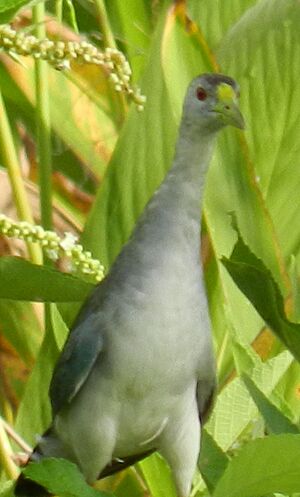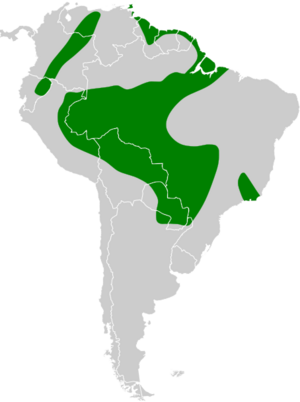Azure gallinule facts for kids
Quick facts for kids Azure gallinule |
|
|---|---|
 |
|
| Conservation status | |
| Scientific classification | |
| Genus: |
Porphyrio
|
| Species: |
flavirostris
|
 |
|
The azure gallinule (Porphyrio flavirostris) is a cool bird that belongs to the group of birds called rails, gallinules, and coots. Its scientific name is Porphyrio flavirostris. You can find this bird in many countries in South America, like Argentina, Bolivia, Brazil, Colombia, Ecuador, French Guiana, Guyana, Paraguay, Peru, Suriname, Trinidad and Tobago, and Venezuela.
| Top - 0-9 A B C D E F G H I J K L M N O P Q R S T U V W X Y Z |
About the Azure Gallinule's Name
The azure gallinule got its official name in 1789 from a German scientist named Johann Friedrich Gmelin. He first put it in a group with birds called coots.
What Does Porphyrio flavirostris Mean?
The name Porphyrio comes from a Latin word for "swamphen." This word originally meant "purple-clad" in Ancient Greek. The second part of its name, flavirostris, is also Latin. Flavus means "yellow," and -rostris means "billed." So, its name basically means "yellow-billed swamphen," which fits because it has a yellow bill!
This bird is unique because it's the only one of its kind. Scientists don't recognize any different types or subspecies of the azure gallinule.
What Does the Azure Gallinule Look Like?
The azure gallinule is a small bird, usually about 23 to 26 centimeters (9 to 10 inches) long. That's about the length of a ruler! Males and females are similar in size and look. Males weigh about 92 to 111 grams (3.2 to 3.9 ounces), and females weigh 92 to 107 grams (3.2 to 3.8 ounces). It's the smallest bird in its family.
Colors and Features
Adult azure gallinules have a pale greenish-yellow bill and a matching shield on their forehead. Their legs and feet are yellow. Their head, back of the neck, and back are a brownish-olive color. The feathers on their upper wings are a pretty azure (sky blue) to greenish-blue. Their flight feathers are gray-blue.
Their face, neck, and chest are a light blue-gray. The rest of their belly is white. Young birds look a bit different. They have browner upper parts and a buffy (yellowish-tan) face, neck, and chest. Their forehead shield is green, and their legs and feet are yellowish-orange.
Where Does the Azure Gallinule Live?
You can find the azure gallinule in many parts of South America. This includes Trinidad and Tobago, Venezuela, Colombia, Ecuador, Peru, the Guianas (French Guiana, Guyana, Suriname), Brazil, Bolivia, and Paraguay. It has also been seen sometimes in Uruguay.
Its Favorite Places to Live
This bird loves freshwater marshes. These are wet, grassy areas with deep water and lots of plants. It also lives in rice fields, wet savannas, and along the edges of swampy streams and rivers. You might also spot it near permanent and seasonal ponds.
Even though it often lives in the same areas as the purple gallinule, the azure gallinule prefers places with shorter plants and no bushes. It usually lives in areas below 500 meters (1,640 feet) in elevation. However, it has been seen as high as 2,600 meters (8,530 feet) in the Andes mountains in Colombia.
How Does the Azure Gallinule Behave?
Moving Around
Azure gallinules often move from one place to another depending on the season. Many of their movements follow the local wet season. For example, they are often seen in the far north between April and August. Then, they move south into the Amazon after that time. In the upper Amazon basin, they are only present from January to July.
They seem to live in southern Colombia and Ecuador all year round. However, they don't breed in northern Colombia. They are also only found in Peru outside of the breeding season.
What Does It Eat?
Scientists are still learning about what the azure gallinule eats. But we know its diet includes grass seeds, different kinds of insects, and spiders. It looks for food both hidden in plants and out in the open on floating plants. It doesn't swim very often. It's quite clever; it climbs on grass stalks and bends them over to reach the seeds.
How Does It Raise Its Young?
The breeding season for the azure gallinule changes depending on where they live. For example, they nest between May and August in Suriname. In Ecuador, they probably nest between June and September. These birds are monogamous, meaning they have one partner. They are also thought to be territorial during the breeding season, meaning they protect their nesting area.
They build their nests out of dead leaves and rushes. They hide these nests well within the marsh plants. Both the male and female birds take turns sitting on the eggs. They usually lay four or five eggs. The exact time it takes for the eggs to hatch is not yet known.
Its Calls
The azure gallinule is usually a quiet bird. But sometimes, it makes a short, soft trilling sound.
Is the Azure Gallinule in Danger?
The IUCN (International Union for Conservation of Nature) has looked at the azure gallinule. They have assessed it as being of "Least Concern." This means it's not currently considered to be in danger of disappearing. It lives across a very large area. However, we don't know exactly how many of these birds there are or if their numbers are growing or shrinking. No immediate threats to the species have been found. You might find it to be uncommon in some places and fairly common in others.


